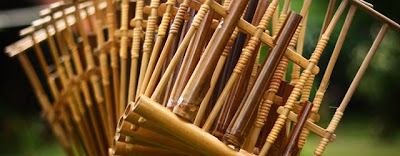Angklung is Indonesia
Angklung is a musical instrument made out of two bamboo tubes attached to a bamboo frame. The tubes are carved so that they have a resonant pitch when struck. The two tubes are tuned to octaves. The base of the frame is held with one hand while the other hand shakes the instrument rapidly from side to side. This causes a rapidly repeating note to sound. Thus each of three or more angklung performers in an ensemble will play just one note and together complete melodies are produced. Angklung is popular throughout Southeast Asia, but originated from Indonesia (used and played by the Sundanese since the ancient times).
In the Hindu period and the era of the Kingdom of Sunda, the people of Sunda, as West Java is called, used the angklung to signal the time for prayer. Later, in Kingdom of Sunda these instruments were used as martial music in the Bubat War (Perang Bubat) as told in the Kidung Sunda.
The angklung functioned to build community spirit. It was used by the Sundanese until the colonial era (Dutch East Indies, V.O.C). At that time, the Dutch East Indies government forbade the playing the angklung. Because of this, the popularity of the instrument decreased and it came to be played only by children.
The angklung got more international attention when Daeng Soetigna, from Bandung, West Java, expanded angklung tuning not only to play traditional pélog or sléndro scales, but also the diatonic scale in 1938. Since then, angklung is often played together with other western music instruments in an orchestra. One of the first well-known performances of angklung in an orchestra was during the Bandung Conference in 1955. A few years later, Udjo Ngalagena, a student of Daeng Soetigna, opened his "Saung Angklung" (House of Angklung) in 1966 as a centre for its development.
text Cr: Wikipedia
pict Cr: angklungisindonesia.com
In the Hindu period and the era of the Kingdom of Sunda, the people of Sunda, as West Java is called, used the angklung to signal the time for prayer. Later, in Kingdom of Sunda these instruments were used as martial music in the Bubat War (Perang Bubat) as told in the Kidung Sunda.
The angklung functioned to build community spirit. It was used by the Sundanese until the colonial era (Dutch East Indies, V.O.C). At that time, the Dutch East Indies government forbade the playing the angklung. Because of this, the popularity of the instrument decreased and it came to be played only by children.
The angklung got more international attention when Daeng Soetigna, from Bandung, West Java, expanded angklung tuning not only to play traditional pélog or sléndro scales, but also the diatonic scale in 1938. Since then, angklung is often played together with other western music instruments in an orchestra. One of the first well-known performances of angklung in an orchestra was during the Bandung Conference in 1955. A few years later, Udjo Ngalagena, a student of Daeng Soetigna, opened his "Saung Angklung" (House of Angklung) in 1966 as a centre for its development.
text Cr: Wikipedia
pict Cr: angklungisindonesia.com




Comments
Post a Comment